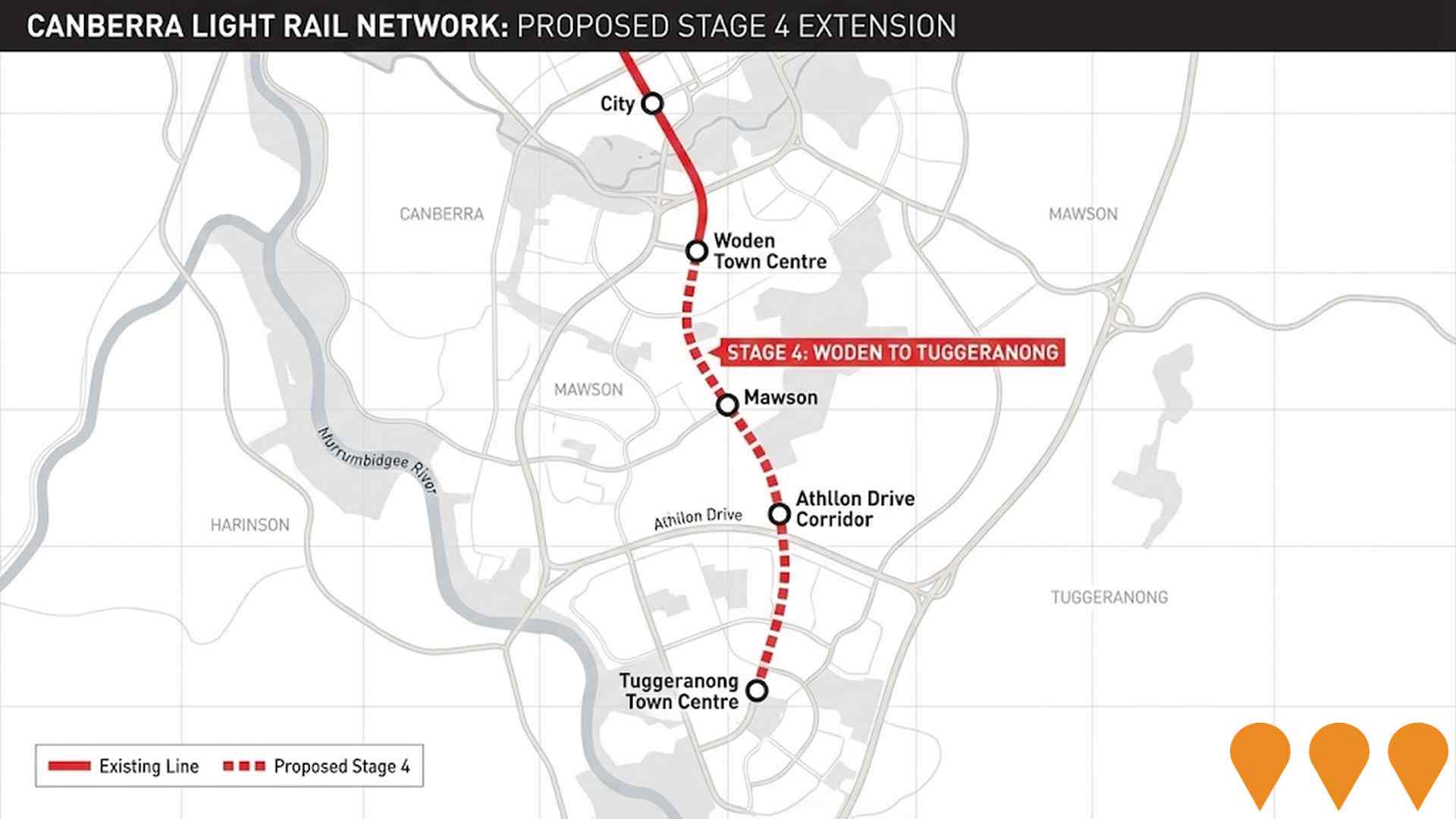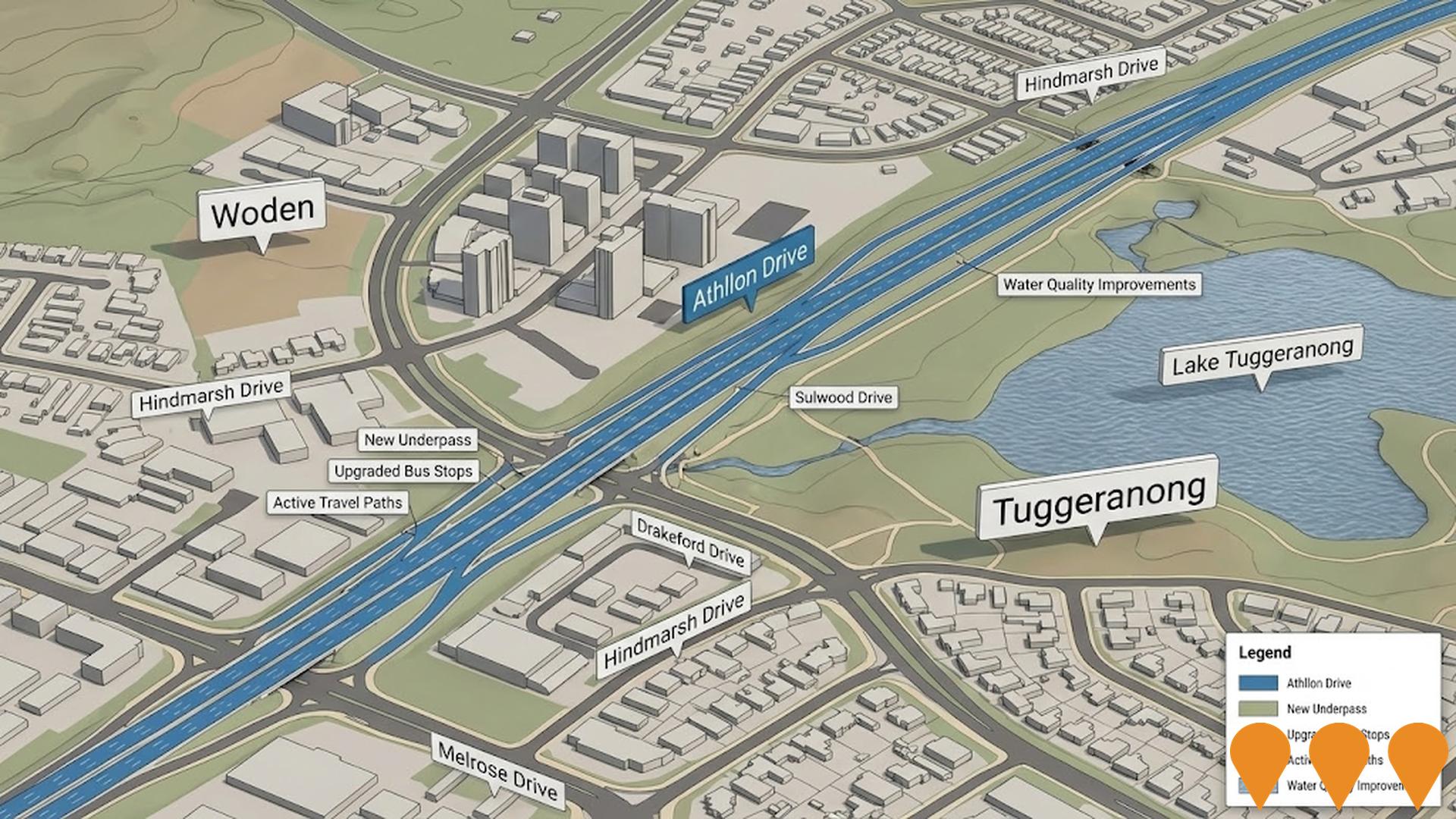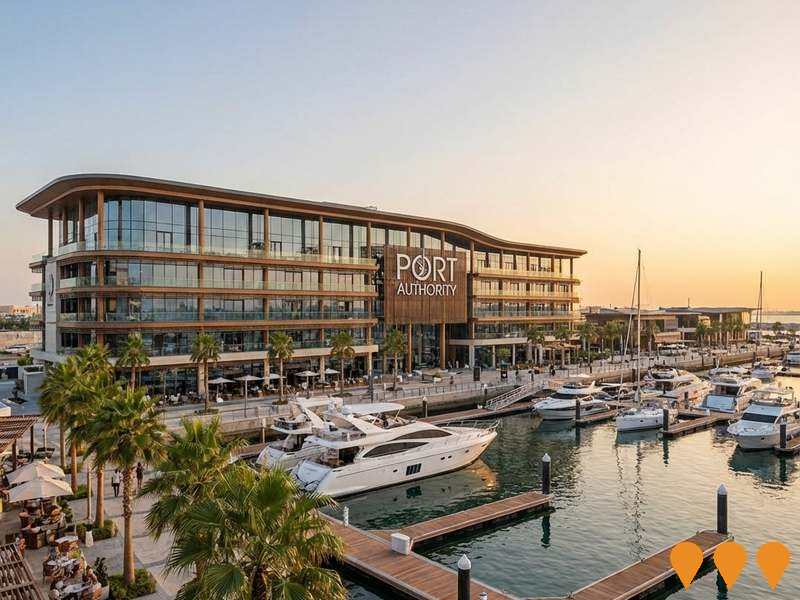Chart Color Schemes
est. as @ -- *
ABS ERP | -- people | --
2021 Census | -- people
Sales Activity
Curious about local property values? Filter the chart to assess the volume and appreciation (including resales) trends and regional comparisons, or scroll to the map below view this information at an individual property level.
Find a Recent Sale
Sales Detail
Population
Pearce is positioned among the lower quartile of areas assessed nationally for population growth based on AreaSearch's assessment of recent, and medium term trends
Pearce's population was 2,687 as of August 2021. By August 2025, it had increased to around 2,730, a rise of 43 people (1.6%). This growth is inferred from the estimated resident population of 2,698 in June 2024 and an additional 32 validated new addresses since the Census date. The population density was 1,605 persons per square kilometer, above national averages assessed by AreaSearch. Overseas migration contributed approximately 61.9% of overall population gains during recent periods.
AreaSearch uses ABS/Geoscience Australia projections for each SA2 area, released in 2024 with a base year of 2022. For areas not covered and years post-2032, age group growth rates from the ACT Government's SA2 area projections are adopted, using 2022 as the base year. Projections indicate a population decline by 175 persons to 2041, with the 65 to 74 age group expected to grow by 32 people.
Frequently Asked Questions - Population
Development
Residential development activity is lower than average in Pearce according to AreaSearch's national comparison of local real estate markets
Pearce has seen approximately 9 new homes approved annually over the past five financial years, totalling 48 homes. As of FY-26, there has been 1 approval recorded so far. On average, each dwelling constructed between FY-21 and FY-25 accommodates around 1.6 new residents per year. The average construction cost for new properties is $319,000.
This financial year, $269,000 in commercial development approvals have been recorded, indicating a primarily residential focus. Compared to the Australian Capital Territory, Pearce shows significantly reduced construction activity, with 78.0% below the regional average per person. This constrained new construction typically reinforces demand and pricing for existing homes. The area's construction rate is also under the national average, suggesting an established nature and potential planning limitations. Recent construction comprises 71.0% detached dwellings and 29.0% townhouses or apartments, maintaining Pearce's suburban identity with a concentration of family homes suited to buyers seeking space.
With around 462 people per approval, Pearce indicates a mature market. Given the expected stable or declining population, housing pressure in Pearce is likely to remain reduced, potentially presenting opportunities for buyers.
Frequently Asked Questions - Development
Infrastructure
Pearce has moderate levels of nearby infrastructure activity, ranking in the 45thth percentile nationally
Changes to local infrastructure significantly impact an area's performance. AreaSearch has identified a single project likely affecting this region: Mawson Group Centre Upgrade, Woden Town Square Precinct Redevelopment, Athllon Drive Duplication, and Canberra Hospital Master Plan are key projects, with the following list detailing those most relevant.
Professional plan users can use the search below to filter and access additional projects.
INFRASTRUCTURE SEARCH
 Denotes AI-based impression for illustrative purposes only, not to be taken as definitive under any circumstances. Please follow links and conduct other investigations from the project's source for actual imagery. Developers and project owners wishing us to use original imagery please Contact Us and we will do so.
Denotes AI-based impression for illustrative purposes only, not to be taken as definitive under any circumstances. Please follow links and conduct other investigations from the project's source for actual imagery. Developers and project owners wishing us to use original imagery please Contact Us and we will do so.
Frequently Asked Questions - Infrastructure
Canberra Hospital Master Plan
Long-term transformation of Canberra Hospital campus (2021-2041). The new Critical Services Building (Building 5) opened in 2023. Multiple stages are now in construction or detailed planning, including SPIRE Stage 1 (new emergency, surgical and intensive care facilities) and ongoing campus renewal works to deliver modern clinical facilities.

Canberra Light Rail Stage 4 - Woden to Tuggeranong
Proposed extension of Canberra's light rail network from Woden Town Centre south to Tuggeranong Town Centre via Mawson and the Athllon Drive corridor. This future stage aims to complete the north-south radial mass transit spine, connecting major residential, employment and activity centres while supporting bus, cycling, walking and private vehicle integration.

Woden Town Square Precinct Redevelopment
A major mixed-use urban renewal precinct featuring a new public town square, residential apartments, commercial office space, retail, and community facilities as the centrepiece of Woden's revitalisation.

Canberra Hospital Critical Services Building (SPIRE Centre)
Australia's first fully-electric hospital building, the Canberra Hospital Critical Services Building (also known as SPIRE Centre), is an eight-storey, 45,000 square metre facility. It includes a new Emergency Department with 128 treatment spaces, a 48-bed Intensive Care Unit with two outdoor terraces, 22 operating theatres, 148 inpatient beds, cardiac catheter laboratories, and enhanced radiology and pathology services. The largest healthcare infrastructure project in ACT history, it was built by Multiplex with a 5 Star Green Star design rating, featuring innovative sustainability measures. Completed and opened August 2024.

Athllon Drive Duplication
The Athllon Drive duplication project upgrades a key arterial road from Woden to Tuggeranong. It includes duplicating 2.4 km between Sulwood Drive and Drakeford Drive, and 600 m between Hindmarsh Drive and Melrose Drive. Features encompass lane duplication, new traffic lights at multiple intersections, upgraded bus stops, active travel paths for cyclists and pedestrians, water quality improvements for Lake Tuggeranong, and a new underpass under Sulwood Drive. Enabling works commenced in 2024 and continue into 2025, with main construction anticipated to span 2-3 years post-planning approvals. The initiative enhances safety, reduces congestion, and supports public transport and future urban growth.

Deakin Private Hospital
Deakin Private Hospital offers premium and integrated inpatient, day therapy, and hospital-in-the-home services, focusing on individualised and high-quality mental health treatment. It includes a Specialised PTSD & Trauma Support Unit for military and first responders, and services such as Repetitive Transcranial Magnetic Stimulation (rTMS) for depression. The hospital also features co-located clinics and is supported by a multidisciplinary team of Psychiatrists, Medical, Nursing, and Allied Health professionals.

Mawson Group Centre Upgrade
A revitalization of the Mawson Group Centre as outlined in the Master Plan. The project aims to create a more attractive and convenient centre with a diverse range of goods, services, and transport and housing options. Key features include establishing five distinct precincts, creating a new public transport hub, and encouraging mixed-use development to boost day and night activity.

Mixed-Use Complex In Mawson
Development of 92 apartments with commercial components, designed by Oztal Architects, includes two buildings and basement parking.

Employment
Employment conditions in Pearce demonstrate strong performance, ranking among the top 35% of areas assessed nationally
Pearce has an educated workforce with 2.4% unemployment rate and 3.0% employment growth in the past year as of June 2025. It has 1,450 residents employed with a 1.0% lower unemployment rate than Australian Capital Territory's (ACT) 3.4%.
Workforce participation is at 64.2%, compared to ACT's 69.6%. Key industries are public administration & safety, health care & social assistance, and professional & technical services. Health care & social assistance has notable concentration, with employment levels at 1.3 times the regional average. Retail trade is under-represented, at 4.8% compared to ACT's 6.6%.
Limited local employment opportunities are indicated by Census data comparison of working population vs resident population. Between June 2024 and June 2025, employment levels increased by 3.0%, labour force by 1.6%, reducing the unemployment rate by 1.3 percentage points. In contrast, ACT saw employment grow by 1.9%, labour force expand by 1.6%, and unemployment fall by 0.3 percentage points. Jobs and Skills Australia's May 2025 national employment forecasts project a 6.6% increase over five years and 13.7% over ten years. Applying these projections to Pearce's employment mix suggests local growth of approximately 6.8%% over five years and 13.9% over ten years, based on simple weighting extrapolation for illustrative purposes.
Frequently Asked Questions - Employment
Income
The economic profile demonstrates exceptional strength, placing the area among the top 10% nationally based on comprehensive AreaSearch income analysis
Pearce has a median taxpayer income of $69,322 and an average income of $92,699 based on postcode level ATO data aggregated by AreaSearch for the financial year 2022. This is notably high compared to national figures, contrasting with the Australian Capital Territory's median income of $68,678 and average income of $83,634. By September 2025, estimated incomes are approximately $78,750 (median) and $105,306 (average), accounting for a 13.6% growth in wages since the financial year 2022. Census data indicates that Pearce's household, family, and personal incomes rank highly nationally, between the 86th and 92nd percentiles. Income analysis shows that 28.9% of Pearce's population (788 individuals) fall within the $4000+ income range, differing from broader area patterns where the $1,500 - $2,999 range dominates at 34.3%. Economic strength is evident with 41.1% of households earning high weekly incomes exceeding $3,000, supporting increased consumer spending. After housing costs, residents retain 86.9% of their income, reflecting strong purchasing power, and the area's SEIFA income ranking places it in the 9th decile.
Frequently Asked Questions - Income
Housing
Pearce displays a diverse mix of dwelling types, with above-average rates of outright home ownership
Pearce's dwelling structures, as per the latest Census, consisted of 63.1% houses and 36.9% other dwellings (semi-detached, apartments, 'other' dwellings). This compares to Australian Capital Territory's 58.4% houses and 41.7% other dwellings. Home ownership in Pearce was at 37.9%, with mortgaged dwellings at 36.3% and rented ones at 25.8%. The median monthly mortgage repayment in Pearce was $2,383, higher than the Australian Capital Territory average of $2,167. The median weekly rent figure in Pearce was $430, compared to Australian Capital Territory's $440. Nationally, Pearce's mortgage repayments were significantly higher at $2,383 versus the Australian average of $1,863, while rents were substantially above the national figure of $375.
Frequently Asked Questions - Housing
Household Composition
Pearce features high concentrations of lone person households, with a higher-than-average median household size
Family households comprise 67.6% of all households, including 32.2% couples with children, 25.1% couples without children, and 9.2% single parent families. Non-family households account for the remaining 32.4%, with lone person households at 30.1% and group households comprising 2.4%. The median household size is 2.5 people, larger than the Australian Capital Territory average of 2.4.
Frequently Asked Questions - Households
Local Schools & Education
Pearce demonstrates exceptional educational outcomes, ranking among the top 5% of areas nationally based on AreaSearch's comprehensive analysis of qualification and performance metrics
Educational attainment in Pearce is notably higher than broader national benchmarks. As of 2021, 50.0% of residents aged 15 and above hold university qualifications, compared to the Australian average of 30.4%. This significant educational advantage positions Pearce strongly for knowledge-based opportunities. Bachelor degrees are the most common at 28.4%, followed by postgraduate qualifications (15.3%) and graduate diplomas (6.3%).
Vocational pathways account for 23.9% of qualifications among those aged 15 and above, with advanced diplomas making up 11.4% and certificates 12.5%. Educational participation is high in Pearce, with 30.2% of residents currently enrolled in formal education. This includes 9.5% in primary education, 8.5% in secondary education, and 6.5% pursuing tertiary education. As of the 2021 census, Pearce's three schools have a combined enrollment of 2,831 students. The area demonstrates significant socio-educational advantages and academic achievement, with an ICSEA score of 1113. The educational mix includes one primary school, one secondary school, and one K-12 school. As of 2021, Pearce functions as an education hub with 103.7 school places per 100 residents, significantly above the regional average of 18.4, attracting students from surrounding communities.
Frequently Asked Questions - Education
Schools Detail
Nearby Services & Amenities
Transport
Transport servicing is good compared to other areas nationally based on assessment of service frequency, route connectivity and accessibility
Pearce has ten active public transport stops, all of which are bus stops. These stops are served by eleven different routes that together facilitate 1,406 weekly passenger trips. The accessibility of these transport services is deemed good, with residents generally residing within a distance of 220 meters from the nearest stop.
On average, there are 200 trips per day across all routes, which translates to roughly 140 weekly trips per individual stop.
Frequently Asked Questions - Transport
Transport Stops Detail
Health
Health outcomes in Pearce are marginally below the national average with common health conditions slightly more prevalent than average across both younger and older age cohorts
Pearce's health indicators show below-average outcomes, with common health conditions slightly more prevalent than average across both younger and older age groups. As of June 30, 2019, approximately 67% (1,831 people) had private health cover, compared to the national average of 55.3%.
The most prevalent medical conditions were arthritis, affecting 9.6% of residents, and asthma, impacting 7.5%. Conversely, 68.2% declared themselves completely clear of medical ailments, slightly lower than the Australian Capital Territory's average of 70.1%. As of June 30, 2019, 19.3% (526 people) were aged 65 and over. Despite this, health outcomes among seniors in Pearce are above average, performing better than the general population in health metrics.
Frequently Asked Questions - Health
Cultural Diversity
Pearce was found to be more culturally diverse than the vast majority of local markets in Australia, upon assessment of a range of language and cultural background related metrics
Pearce's population was found to be more culturally diverse than most local markets, with 25.3% born overseas and 18.7% speaking a language other than English at home. Christianity was the predominant religion in Pearce as of 2021, comprising 52.8% of its population. Notably, Judaism was overrepresented in Pearce compared to the Australian Capital Territory, with 0.4% of its population identifying as such versus 0.3%.
The top three ancestry groups in Pearce were English (24.5%), Australian (22.5%), and Irish (11.5%). Some other ethnic groups showed notable differences: Hungarian was overrepresented at 0.6% compared to the regional average of 0.3%, Spanish at 0.8% versus 0.5%, and Croatian at 1.1% against a regional average of 0.8%.
Frequently Asked Questions - Diversity
Age
Pearce hosts an older demographic, ranking in the top quartile nationwide
Pearce's median age is 43 years, significantly higher than the Australian Capital Territory average of 35 and the Australian median of 38. The 55-64 cohort is notably over-represented in Pearce at 14.2%, compared to the Australian Capital Territory average, while the 25-34 age group is under-represented at 9.4%. Post the 2021 Census, the 35-44 age group grew from 11.9% to 13.3%, and the 55-64 cohort increased from 12.8% to 14.2%. Conversely, the 45-54 cohort declined from 14.7% to 13.3%, and the 65-74 group decreased from 10.0% to 8.8%. By 2041, demographic modeling projects significant changes in Pearce's age profile. The 65-74 cohort is projected to grow by 11%, adding 27 residents to reach 266. Residents aged 65 and older will represent all anticipated population growth due to demographic aging. Conversely, population declines are projected for the 55-64 and 75-84 cohorts.

